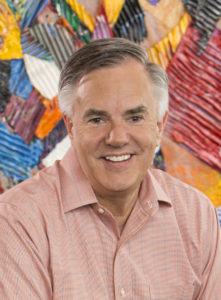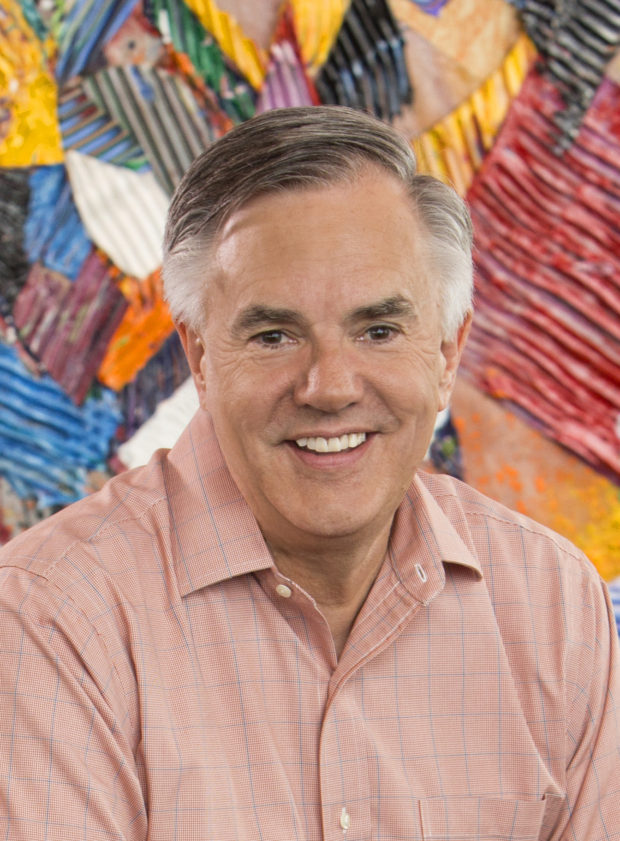Although technology may be top of mind for Acuity Insurance’s president and chief executive officer, it’s the people that make the insurer a standout. The answer to the question of whether to delegate or empower employees has been the driving force of success at this top-ranked insurer.
Ben Salzmann, a former technology officer now in his 19th year with the Wisconsin-based regional carrier, was actually on a path to becoming a doctor when he decided he couldn’t stomach the sorrow he encountered during rounds. He went back to school and obtained his MBA but found that technology was often an impediment to getting projects approved. The experience prompted him to get a computer information systems degree.
His insurance career began in marketing at Foremost Insurance, where he later moved into technology.
“I led teams to build new systems. From there I came over to Acuity, then called Heritage, as their vice president of information technology,” Salzmann said.
Turning Things Around
The 93-year-old company wasn’t always successful. When Salzmann took over as CEO, Acuity reported a combined ratio of 116. It was then known as Heritage Mutual Insurance Co.
“Heritage had a 28 percent turnover. Compounded, the entire company quit every three years,” he said.
According to Salzmann, he didn’t have a lot of insurance experience, but he knew information technology and recognized the positive changes he could make.
“You could take over immediately, a very direct control where you drive everything, but you’re not changing the culture,” he said.
“You can delegate,” but delegation is very limiting because when you’re delegating, “you’ve already made up all the decisions and charted a narrow course. Then you tell people to follow this cooking recipe.”
Alternatively, “you can empower,” explained Salzmann. “Empowering’s very uncomfortable while you’re going broke. That’s not a natural human instinct at that moment.”
The CIO turned CEO recognized that he had to rebuild the company from the ground up.
“We had to build trust. Then we had to build operational excellence. We really had to emphasize innovation. We had to focus on our customer in this changing digital world,” he said. “That’s a challenge, and it’s also a gallows situation. How do you respond to an everyone’s‑getting‑their‑head‑cut‑off situation? By gallows humor. So, I did a lot of different stunts.”
Salzmann used humor to soften the strict atmosphere created by his predecessor. The prior CEO used bells to keep employees in line.
“At 9:30 a bell would ring, and you’d have 11 minutes to take a break. A bell would ring at 9:41, you’d have four minutes to use the bathroom, and then at 9:45 the bell would ring, and you’d better be back at your desk,” Salzmann explained.
Months into his new role, he rang the bells again mocking the prior regime.
Humor also played into the renaming of the company back in 2001.
“We wanted to rename the company from Heritage because that’s the name of every nursing home. I hired two Madison Avenue firms, and the best name they came up with was Infinium,” Salzmann said. “I paid six figures for that. My wife sees that and just goes nuts mocking me. She says, ‘That sounds like a laxative.'”
Salzmann and his wife came up with the name the carrier uses today.
“It starts with an A at the beginning, a lot of syllables but only six letters. Keenness of vision, clearness of perception—Acuity,” he said, adding that he had paper, pens and even a website created with the name Infinium to throw his employees off course.
Joking aside, he recognizes the many close calls he had in the beginning.
“I was in a lot of positions where had I made the wrong call, it would have ended immediately. Within the first month of being the president and CEO of Heritage, now Acuity, the president of the bank we owned stated that I had to give him more control or he was going to quit,” Salzmann said. “Not only did I not know anything about insurance, I didn’t know anything about banking. I said, ‘That sounds like a resignation to me,’ and I accepted that resignation. I brought in somebody else who ran it for a while, saw that I’d rather partner with banks than own a bank and sold the bank.”
Many intuitive decisions were made alone in the beginning, he said.
“The problem is when you get to the last edge of entrepreneurialship, and you’re running a 99 percent chance of failure and a 1 percent chance of making the company 10-times bigger in three years, I didn’t take that last 1 percent/99 percent chance of bankrupting the company,” Salzmann said. “There is still that last risk management insurance aspect in me. I never bet our 350,000 insureds’ protection, our millions of people we cover and our 1,300 employees on a 1 percent chance or a 99 percent chance of failure—of rolling into the craziest product only to have it turn into a Microsoft Windows. I always stayed within my risk appetite.”
2018 Challenges
He said the biggest challenges for property/casualty insurance CEOs in 2018 will be strategic planning and remaining relevant.
“We’re incessantly analyzing our strengths, our weaknesses…and then we turn around, and based on what’s new and rising, we bring in speakers,” said Salzmann. Acuity hosts several speakers early in the year to update and add to their strategic plan. The insurer’s strategic planning team jot down takeaways from the event and create an actionable to-do list.
“We merge them into our previous existing strategic initiatives, about 25 of them. We assign one human being—and only one human being—to those 25, and they have to report back to us. We meet with them every month to make sure they’re staying on track,” Salzmann said. “We are intensely focused on innovation, strategic planning.”
The firm also has two major time frames: a five‑year plan driving profitable growth and a 15‑year plan driving the goal to remain relevant.
“One of the big things we have going for us is we’re not trying to make the next three months’ quarterly profit report. We’re looking at what is going to maintain our combined ratio,” Salzmann said.
“Most CEOs have a tenure of about three-and-a-half years, which leads them to make a lot of short‑term decisions to get quarterly results in a fat company environment,” he explained. “I’m in my 19th year. We have a five‑year horizon, a rolling five. We drop a year, we add a year, always looking out five years. What is going to lead to the most profitable growth?”
The insurer’s results reflect its efforts, boasting a combined ratio of 95 percent for the past 17 years.
“The industry averaged 103.1—eight full percentage points difference for that 17-year period,” said Salzmann. “Our sales growth over the 17 years, soon to be 18 years, is 10.5 percent. The industry’s is 4.5 percent. Our surplus growth has grown 13.8 percent over those 17 years, and the industry, 5.7. Now, 2017, our combined ratio’s going to be about a 95. The industry’s is going to be somewhere between 105 and 110. We may roast the industry by 15 points.”
Salzmann says Acuity is generating nearly four-times the cash flow as compared to the industry average.
“Results speak for themselves. We grew our sales over 200 percent faster than the industry. We grew our equity, our capital, in the last 18 years by more than 1,000 percent. Our profit margin is eight percentage points higher than the industry,” he added.
As far as industry changes, rather than fear InsurTech, he embraces it.
“This is one of those moments where I definitely want to be leading edge. I don’t want to be bleeding edge. We’re paying attention to it. We’re redefining our traditional products to work more along those lines and getting ready to move into those lines,” Salzmann said. “We are assuming there is no car insurance product 15 years from now.”
Many InsurTech companies aren’t true insurers, he added.
“They have one idea, one gimmick, and it’s a good gimmick. We’re going to assimilate it, we’re going to use it,” he explained. “A lot of these InsurTech companies are going to be rapidly obsolete themselves. One‑hit wonders. Meanwhile, these digital virtual insurance agencies selling commercial insurance, they are a thing of the future.”
He added that InsurTech is a catalyst, not a solution, for insurers that outsource processing and use it to avoid innovation.
Acuity Campus Reflects Investment in Employees

Walking within the million-plus-square-foot campus, you might think you’re on a Disney adventure. Four‑foot tall gargoyles with nine‑foot wingspans adorn the building, 15-foot-wide glass sculptures of the Seven Sisters hang from the ceiling, and a Mall of America Ferris wheel sits inside.
“We’ve got 20-foot-tall yin and yang sculptures that show it takes the new college grad and the seasoned veteran—that it takes management and analysts,” said Salzmann.
There’s a Shakespearean theater in the round and a torture chamber in the basement.
“When we give out our free flu shots, we line up employees to go through the torture chamber. I sit in the torture chamber, and I wail in agony for the people waiting to come in,” joked the unconventional Salzmann.
There’s also a 27,000-square-foot workout facility, scores of ping pong tables and a 45‑foot climbing wall.
“The goal is to infuse excitement and enthusiasm, to eliminate barriers to imagination,” he said. “The competition is too tough. You can’t compete anymore and survive. Don’t compete; innovate,” he said.
All employees, whether paid a salary or by the hour, have unlimited sick leave. An employee diagnosed with a terminal disease won’t be placed on long‑term disability, he added.
“They get full pay. If they’re alive through year‑end, they get a merit increase,” Salzmann said. “We put 10.5 percent into everybody’s 401(k), even if an employee doesn’t have enough money to match.”
If a company is focused on recruiting millennials, they already are too late, said Acuity Insurance President and CEO Ben Salzmann. The insurer begins the recruitment process early by introducing the company to kids.
“We run statewide chess tournaments. We do 4‑H because if five kids are growing up on the farm, one can run the farm. We want to hire the other four,” said Salzmann.
The insurer hosts spelling bees, a variety of competitions and runs the statewide Junior Achievement Business Ball.
“We spend a lot of money sponsoring these. The rule is every event must be at Acuity. Either that or the UW-Madison. We have the Mall of America Ferris Wheel in our building. We run 1,500 eighth graders on that Ferris wheel every academic year. We feed them pizza. We give them a gift,” he added.
He discounts the notion that he has innate leadership qualities.
“The thing that drives me is I have a fierce need for individualism,” he said. “I need to be an individual, but I also need to have everyone in my company feel like an individual.”
His leadership style can be summed up in one word: people.
“People achieving their most. You can say I’m people-oriented,” he said.
Acuity offers both external and internal leadership development programs, and Salzmann is very much involved and focused on succession planning.
“My role here is to groom everybody,” he said. “I am always looking at rising talent in every position. It is so ingrained in everything we do. We send people off to Wharton or other schools for intense training. We also go through succession plans with our board of directors annually.”
Salzmann shares his driving philosophy.
“Reach out to the next generation. Innovate, innovate, innovate,” he said. “Fail by action, not passive fear. Be persistent. I was never the first choice. I was a third grader in the schoolyard waving my arm, ‘Pick me, pick me.'”
“Always have fun.”





















 ‘Dream Is in Sight:’ Chamber, Reinsurers, Insurers Urge Florida to Stay the Course
‘Dream Is in Sight:’ Chamber, Reinsurers, Insurers Urge Florida to Stay the Course  AI in Property/Casualty Insurance: Why Trusted Data Is the Missing Link
AI in Property/Casualty Insurance: Why Trusted Data Is the Missing Link  The Latest Launches from Allstate, WTW, Whisker Labs
The Latest Launches from Allstate, WTW, Whisker Labs  Berkshire Hathaway Announces Leadership Appointments: New CEO at GEICO
Berkshire Hathaway Announces Leadership Appointments: New CEO at GEICO 







